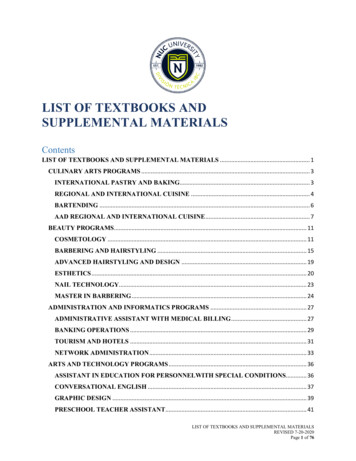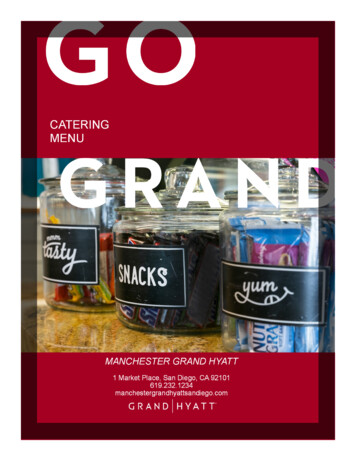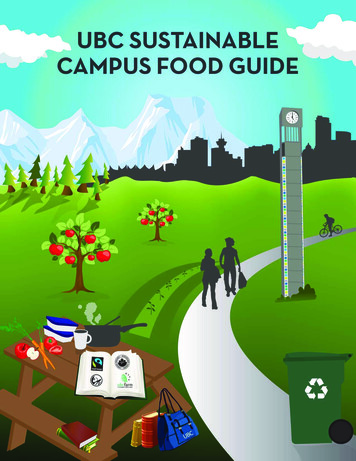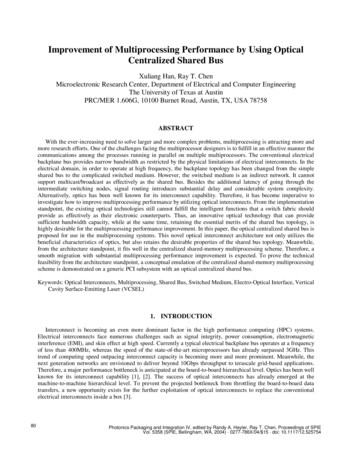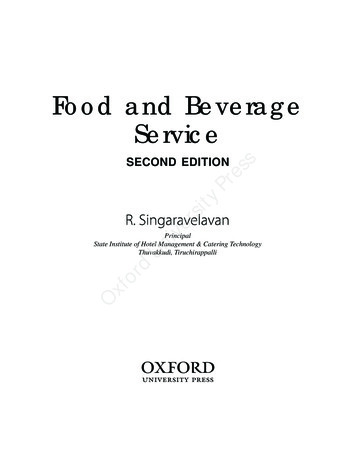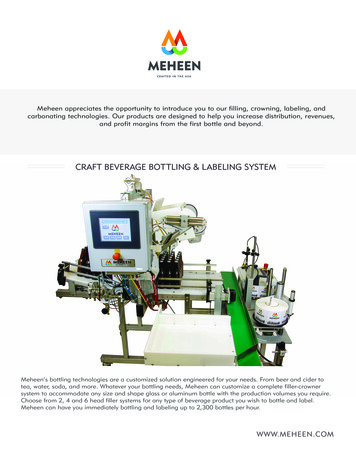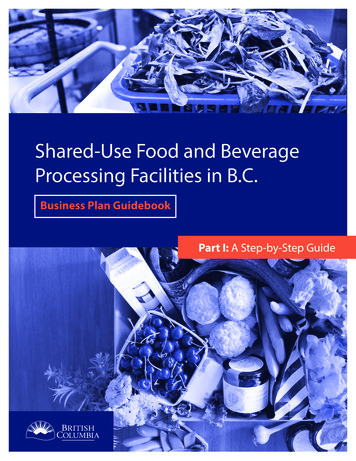
Transcription
Shared-Use Food and BeverageProcessing Facilities in B.C.Business Plan GuidebookPart I: A Step-by-Step Guide
Guide Contents3. 1.0 Introduction3. 1.1 Purpose3. 1.2 Terminology7. 1.3 Examples of Shared-Use Processing Facilities and Food Innovation Centres9. 2.0 Planning Your Shared-Use Processing Facility9. 2.1 Feasibility Study10. 3.0 Business Plan Outline20. 4.0 Additional Resources20. 4.1 Business Planning Consultants21. 4.2 Funding Opportunities22. 4.3 Suggested Resources24. Appendix A: 2019 B.C. Food and Beverage Industry Survey Results25. Appendix B: Feasibility Study Template25. Contents25. 1.0 Executive Summary25. 2.0 Introduction25. 2.1 Purpose of Study26. 2.2 Lead Organization and/or Project Manager(s) Leading the Study26. 3.0 Methodology26. 3.1 Project Timeline26. 3.2 Project Funding26. 3.4 Industry/Client Engagement Process26. 4.0 Findings26. 4.1 Overview of the Regional Agriculture and Food Sector26. 4.2 Existing Infrastructure and Services in the Region27. 4.3 Related Studies in the Region27. 4.4 Regional Industry/Target Client Needs and Opportunities27. 4.5 Proposed Facility Model27. 4.6 Financial Projections29. 5.0 Recommendations29. 5.1 Vision and Opportunities for the Shared-Use Processing Facility29. 5.2 Governance Structure30. 5.3 Potential Facility Locations30. 5.4 Potential Challenges and Opportunities30. 5.5 Suggested Next Steps30. 6.0 Conclusion30. Appendix C: Example Shared-Use Processing Facility Spaces, Equipment and Services2Shared-Use Food and Beverage Processing Facilities in B.C. Business Plan Guidebook
1.0 Introduction1.1 PurposeThe Business Plan Guidebook was createdby the B.C. Ministry of Agriculture, Food andFisheries as a starting point for organizationsthat are interested in establishing shared-usefood and beverage processing facilities in B.C.The guidebook provides a high-level overviewof the B.C. food and beverage processingsector, business planning considerations for ashared-use processing facility in B.C., a businessplan template for a shared-use facility andadditional resources.1.2 TerminologyThis guidebook uses the term shared-useprocessing facility to refer to any commercialinfrastructure with value-added food orbeverage manufacturing equipment thatis accessed by multiple food and beveragebusinesses. The food industry uses many termssimilar to shared-use processing facility – such ascommissary kitchens, incubator kitchens andfood incubators – and these variations reflect theongoing evolution of innovative facility models.Definitions also tend to vary by jurisdiction andregional needs. Overall, shared-use processingfacilities tend to focus on supporting local foodproduction and processing activities and offeringfood and beverage small-to-medium enterprises(SMEs) access to facilities and equipment withoutthe associated high start-up costs of acquiring afacility and equipment as an individual business.Part I: A Step-by-Step Guide3
The table presented below introduces a range of food processing facility models (but is not exhaustive). *Aggregation & Distribution ServicesIncubator / Accelerator KitchenA commercial kitchen with businessdevelopment services for food businessstart-ups. Typically for limited-time use,before a business is able to move into itsown facility.*Business Development Services**Packaging, Bottling, & Labelling ServicesCommunity KitchenA standard kitchen with equipment andsupplies, generally found at communitycentres, neighbourhood houses orchurches. These kitchens are normallyavailable to community groups orcatering businesses at reduced rates.They may be accessed by smallbusiness, but their primary purposeis for serving social and communityobjectives. Advanced Research & Development Services Testing / Product Development Services Office / Instruction SpaceSpecialized Processing EquipmentShared-Use Processing Facility /Commissary / Commercial KitchenProvincially- or federally-inspectedfacility with professional foodpreparation space and value-addedfood processing equipment, primarilyfor commercial production purposes.OTHER ELEMENTSBasic Food Preparation SpaceShared-Use Commercial Food Production SpaceFACILITY DESCRIPTIONCRITERIA OFSHARED USEPROCESSINGFACILITY ** * Indicates elements that are generally (but not always) offered by the facility.Facility Description Criteria of Shared-Use Processing4Shared-Use Food and Beverage Processing Facilities in B.C. Business Plan Guidebook
Food Business AcceleratorA short-term business programincluding networking opportunities,entrepreneurial training and industrysupport services for food business startups. Some programs have a competitiveselection process. May be offeredwithin or separate from a shared-useprocessing facility.* Aggregation & Distribution ServicesBusiness Development Services Processing Centre / Co-PackerPrivate sector facility with equipment toprocess and package food and beverageproducts for other businesses.Regional Food Processing andInnovation Hub (according tothe Ministry of Agriculture, Foodand Fisheries BC Food Hub Networkprogram)A shared-use processing facility forsmall- to medium-sized food andbeverage producers and processorsthat integrates food processing andinnovation activities and services.Packaging, Bottling, & Labelling ServicesAdvanced Research & Development ServicesTesting / Product Development ServicesOffice / Instruction SpaceOTHER ELEMENTSBasic Food Preparation SpaceSpecialized Processing EquipmentShared-Use Commercial Food Production SpaceFACILITY DESCRIPTIONCRITERIA OFSHARED USEPROCESSINGFACILITY * * ** Indicates elements that are generally (but not always) offered by the facility.Facility Description Criteria of Shared-Use ProcessingPart I: A Step-by-Step Guide5
Basic Food Preparation SpaceOffice / Instruction SpaceTesting / Product Development ServicesAdvanced Research & Development ServicesPackaging, Bottling, & Labelling ServicesBusiness Development ServicesFood Innovation /Development CentreA large-scale commercial kitchen orprocessing facility offering technicalexpertise, business support andadvanced laboratory testing andresearch and development (R&D)services. Typically has greater emphasison R&D services than providing accessto space for day-to-day production.Generally owned by or in partnershipwith government or academia.* ** **Food Hub (according to the U.S.Department of Agriculture) A regionalfood hub is a business or organizationthat actively manages the aggregation,distribution, and marketing of sourceidentified food products primarilyfrom local and regional producersto strengthen their ability to satisfywholesale, retail, and institutionaldemand.****Aggregation & Distribution ServicesSpecialized Processing EquipmentOTHER ELEMENTSShared-Use Commercial Food Production SpaceFACILITY DESCRIPTIONCRITERIA OFSHARED USEPROCESSINGFACILITY * Indicates elements that are generally (but not always) offered by the facility.Facility Description Criteria of Shared-Use Processing6Shared-Use Food and Beverage Processing Facilities in B.C. Business Plan Guidebook
1.3 Examples of Shared-UseProcessing Facilities andFood Innovation CentresThe following are examples of shareduse processing facilities in B.C. andother Canadian provinces:BC Food Hub Network Shared-UseProcessing Facilities Commissary Connect, Vancouver, B.C.:Commissary Connect is a leader in peoplefocused, professionally-run, shared-usecommercial kitchen spaces. The facility offersits member businesses 24/7 access to shareduse processing facilities, technology, andequipment to assist with the booking andbilling of equipment and business advisory andproduct development services. CommissaryConnect’s Laurel Street facility in SouthVancouver is the Pilot and Demonstration FoodHub of the BC Food Hub Network. Plenty & Grace Food Hub & Innovation Centre,Surrey, B.C.: Plenty & Grace is a shared-use,commercial manufacturing space focused onthe processing of local B.C. fruits, vegetables,tree nuts and herbs for value-addedproduction. In addition to offering shared-usefood processing space, Plenty & Grace offersservices including co-packing, food businessconsulting, lab services, B.C. ingredientsourcing, and product distribution support. The Dock , Port Alberni, B.C.: The Dock isa shared-use food processing facility thatprovides businesses affordable access toprocessing space and specialized equipment.The Dock is comprised of a shared-usecommercial kitchen, offering space forprocessing agricultural commodities or seafoodprocessing, including services such as smoking,blast freezing, and cold storage space. Sprout Kitchen, Quesnel, B.C. (launching 2021):Sprout Kitchen will offer space and support forexisting and emerging food entrepreneurs inthe North Cariboo Region. Sprout Kitchen willprovide businesses with access to infrastructureand services including processing and testingequipment, food business advisory services,product development services, analyticservices, applied research opportunities,and education and training related to foodprocessing and food safety. Zest Commercial Food Hub, Salmon Arm,B.C. (launching 2021): The Zest Food Hub, ledby the Salmon Arm Economic DevelopmentSociety, will offer food and agriculturebusinesses in the Shuswap Region access toshared food and beverage processing space,equipment, and services. Cowichan Valley Food Hub, CowichanValley, B.C. (launching 2021): The CowichanValley Food Hub, led by the CowichanGreen Community Society, will offer acommercial teaching kitchen, processingkitchen, and aggregation space to local foodproducers and processors. Thompson-Nicola Food Hub, Kamloops, B.C.(launching 2021): The Thompson-Nicola FoodHub, led by the Kamloops Food Policy Council,will help local businesses in Kamloops accessshared commercial kitchens and a trainingcentre for food and beverage processing. Capital Region Food Hub, Victoria, B.C.(launching 2021): The Capital Region FoodHub, led by the Victoria Community Food HubSociety, will offer a shared processing andpackaging facility, and aggregation space tolocal processors and producers.Part I: A Step-by-Step Guide7
Fraser Valley Artisan Food Hub, Abbotsford,B.C. (launching 2021): The Fraser Valley FoodHub, led by the Mission Community SkillsCentre Society, will offer shared kitchenspace for food processing and commercialproduction, and customized training programsfor the food sector. Centre for Seafood Innovation, Bowser, B.C.(launching 2021): The Centre for SeafoodInnovation, led by Vancouver Island University,will offer seafood producers and processorscommercial test kitchen space, laboratories,and event and training space. The centre willoffer services including applied R&D, productdevelopment, regulatory coordination andconsulting, food safety testing, and trainingand education to the seafood sector. Kootenay Boundary Food Hub, Rock Creekand Greenwood, B.C. (launching 2021): TheKootenay Boundary Food Hub, led by theWest Boundary Community Services Coop Association, will offer a co-packing andprocessing kitchen to meat producers inRock Creek, and a bakery test kitchen toprocessors in Greenwood. Central Kootenay Food Hub, Creston, B.C.(launching 2021): The Central KootenayFood Hub, led by Fields Forward, willoffer co-packing space, shared-use foodpackaging space, storage facilities, andwet and dry processing equipment to localproducers and processors.Other Shared-Use Processing Facilities BC Beverage Technology Access Centre,Penticton, B.C.: Okanagan College’s BCBeverage Technology Access Centre is a newfederally-funded technology access centre thatwill provide services to the wine, beer, spirits,cider, and beverage industries through newand existing product development, testing,and technology. It will also offer market/8consumer research and analysis, includingassisting clients in understanding their currentand potential markets, consumer preferences,and developing operational or brand support. The Alberta Food Processing DevelopmentCentre, Leduc, Alberta: The Alberta FoodProcessing Development Centre is a modern,fully-equipped, pilot plant and productdevelopment laboratory facility staffed withexperienced food scientists, engineers andtechnologists who work with entrepreneurs todevelop and fine-tune their products. The Kitchen Collective, Hamilton, Ontario: TheKitchen Collective is a non-profit, affordablecommercial kitchen and culinary incubatordesigned to give aspiring entrepreneurs aboost in the industry as well as a collaborativespace in which to launch their business andlearn from each other. As a co-operative,the Kitchen Collective is owned andoperated by its members, allowing theservices provided to remain in line with theneeds of its membership. BIO FOOD TECH, Charlottetown, PrinceEdward Island: BIO FOOD TECH providesprofessional technical services to the foodand bioprocessing industries from concept,to pilot, to market through three integratedbusiness divisions: food technology, biosciencetechnology, and lab services.In addition to the shared-use processingfacilities and food innovation centres mentionedabove, there are many other examples locatedacross Canada and in other countries that canserve as models and resources to inform thedevelopment of new initiatives.Shared-Use Food and Beverage Processing Facilities in B.C. Business Plan Guidebook
2.0 Planning Your SharedUse Processing FacilityA critical component of developing shared-useprocessing facilities is conducting feasibilitystudies. This early scoping activity will help youto tailor your business to meet client needs,identify opportunities, and assess financialfeasibility. Undertaking this thorough marketassessment may reaffirm your business ideaor help you identify adaptations for yourbusiness to better meet the needs of yourtarget market. If your findings indicate thata shared-use processing facility in your regionwould be in demand, financially sustainableand logistically sound, the next step is todevelop a business plan.Prior to establishing a feasibility study, an onlinesearch and engagement with regional foodand agriculture organizations is recommended,to see if previous feasibility studies or similarprojects have been completed for shared-useprocessing facilities or related industry supportsin your area. Consulting these reports can revealinsights relevant to your study and can saveyou time and money. For example, in 2019,the Ministry of Agriculture, Food and Fisheriesconducted a food and beverage processingindustry survey to identify the needs, challengesand opportunities of B.C. food and beverageprocessors. Appendix A provides a summary ofthe top interests of both the overall sector andB.C. regions that were identified by the surveythat your business may want to consider duringthe market assessment process.2.1 Feasibility StudyA feasibility study for a shared-use processingfacility generally consists of an assessment of theneeds of local food producers and processors(target clients) in the areas of processing, foodsafety, training and education, research, businessdevelopment support, facilities, storage andequipment. Appendix B provides a feasibilitystudy template. A feasibility study may alsoconsist of a broader market assessment,considering the demand or market opportunitiesfor the types of processed products that wouldbe produced at the shared-use processing facility,helping to inform the type of processing andequipment to focus on and/or which clients toengage. The market assessment can also informthe financial viability of a shared-use processingfacility at the proposed location.Hiring a consultant to conduct your feasibilitystudy is recommended to establish an objectiveview on the viability of your business; however,in-house assessments are possible when fundingconstraints exist. The creation of an advisorybody, comprised of industry and projectstakeholders, is a mechanism that can provideguidance to the development of the business.Section 4.1 offers examples of business planningconsultants and Section 4.3 includes additionalbusiness planning resources.Prior to completing your feasibility study, it issuggested that you review the business planoutline in Section 3, which includes guidingquestions that you may wish to consider duringthe development of your feasibility study.If your shared-use processing facility model isdetermined to be viable, a business plan can beestablished for your facility using the outline inSection 3. Your feasibility study will form the basisof your business plan report and informationfrom the feasibility study is often transferrableto the business plan.Part I: A Step-by-Step Guide9
2.2 Business PlanExecutive SummaryAs with the feasibility study process, engagingwith industry and collecting feedback frompotential clients is valuable for the businessplanning process. Advice from industryexperts can be sought during business plandevelopment or for review of the completedbusiness plan. Unlike feasibility studies, businessplans are generally completed in-house but mayalso be written with assistance from a businessplanning consultant.What to include here:For developing your business plan, see the‘Shared-Use Food and Beverage ProcessingFacilities in B.C. Business Planning Guidebook– Part II: Business Plan Template’ for a usablebusiness plan template. Instructions on howto complete the business plan template andadditional guiding questions that are specific toshared-use processing facilities are provided inSection 3 of this guidebook.Business DescriptionIn addition to this guidebook’s business plantemplate, it may be helpful to familiarizeyourself with other business plan templatesavailable online for additional ideas on contentand layout. As reports vary, it is recommendedto review online business planning resourcesand information that are most relevant to yourshared-use processing facility concept and thatmeet the criteria of your report’s audience (e.g.,banks, investors, funding agencies). Who are your target clients (e.g., any typeof food and beverage business, a specificsub-sector of food and beverage processing,caterers, bakers, food trucks, others)?3.0 Business Plan Outline What is your vision and what are your values?The following business plan outline includesinstructions on how to complete the businessplan template (see the ‘Shared-Use Food andBeverage Processing Facilities in B.C. BusinessPlanning Guidebook – Part II: Business PlanTemplate’) and guiding questions related togeneral business considerations and thoseunique to shared-use processing facilities in B.C.10A brief summary of the contents of the businessplan, which can be written after completing theother sections of the plan. What to include here: What are key takeaways from eachsection of this report?Business OverviewWhat to include here: Why are you interested in developing a shareduse processing facility? Within which city/region will yourfacility be located?Mission, Vision and ValuesWhat to include here: What is your mission statement? Will your shared-use processing facility generatesocial benefit(s) (e.g., food security, foodliteracy, training and skills development)? How will your shared-use processingfacility model align with yourmission, vision and values?Shared-Use Food and Beverage Processing Facilities in B.C. Business Plan Guidebook
Ownership, Governanceand Management TeamRegional Overview and Market TrendsWhat to include here:What to include here: What will be the legal structure of the facility(e.g., sole proprietorship, general partnership,corporation, cooperative, non-profitorganization, social enterprise)? Consider thestructure that best suits your objectives (e.g.,social, financial or both), your activities, andyour expected sources of funding/income. Ifyou are not sure which structure is best suitedto your facility, a lawyer or accountant canadvise from a legal and financial perspective.Information is also available online onbusiness structures, societies (not-forprofit corporations) and different structuresfor social purposes. Who will own the operation? Whatmakes them qualified? Who will manage the operation? Whatmakes them qualified? Is it important to have a Board of Directorsand/or an advisory group? If yes, whatare the roles and responsibilities of themembers and what will the selectionprocess, service term and compensation (ifapplicable) be for the members?Market ResearchIndustry Overview and TrendsWhat to include here: What are the main production and processingactivities occurring in the region? What are the current trends for the regionand what is the outlook for the region?Are there emerging markets or nicheproduct opportunities? Are there geographic features or limitationsfor the region (e.g., proximity to ports, ruralsetting, primary agricultural commodities)?Needs Assessment and Gap AnalysisWhat to include here: What infrastructure, equipment andservices are not currently offered inyour region? Identify needs that are notbeing met by existing industry supportsand conduct research on why theseneeds are not being met. If suitable infrastructure, equipment, andservices are offered but underutilized,determine what barriers or challengesprospective clients are facing. Are existingsupports too expensive? Are there regulationslimiting the availability of these resources? Which gaps will you fill and how?Note: Appendix C provides examples of shared-use processing facility spaces,equipment and services for which you may wish to assess demand duringyour market research. Who is part of the industry and howlarge is the industry? What are the current trends in the industry andwhat is the industry outlook?Part I: A Step-by-Step Guide11
Target Market and ClientsCompetitor AnalysisWhat to include here:What to include here: Will your facility serve all types of food andbeverage processors, or will it focus on aspecific sub-sector or commodity area (e.g.,seafood sector, berry processing)? Focusingon a segment of the sector may allow for theestablishment of more specialized supportand the ability to afford and house specializedequipment, however, it may also result inhaving a smaller client base. Describe whoyour target clients are (e.g., type of business,company size, location) and their existinglevel of demand for processing infrastructure,equipment and services. Who are your direct and indirect competitors?What do they offer and what will you offer? Will you have anchor tenants? Anchor tenantsare permanent or long-term users of a facility.Anchor tenants can contribute to the successof a shared-use processing facility by providingregular rental income, helping to determineequipment needs and facility design duringthe construction phase of the facility (if theanchor tenants are confirmed in advance) andproviding mentorship to other clients. What are your prospective client’s targetmarket channels (e.g., farmers’ markets,catering and events, food trucks, independentretailers, national retailers, public institutions,export markets)? Note that the marketchannels of your prospective clients haveimplications for food safety requirements andthe facility scale/production capacity yourfacility will need to meet. Will you offer an on-site retail marketfor food processors to sell directly toconsumers? Describe your targeted retailaudience and their needs. Will you offer training and workshops? Describeyour target audience and their needs.12 What is your positioning strategy? In otherwords, what will you do to differentiate yourfacility from others? Identify infrastructure,equipment and services already available toyour target clients and determine ways todifferentiate your business.Facilities, Equipmentand ServicesWhat to include here: For what purpose(s) do your target clientsneed your facility? What type of physicalspace and design would best support thetargeted activities? Is there seasonality to the type of processingthat would occur in your facility? If yes, how willrevenue be generated off-season? What are the components of your facility andits services that will generate revenue?LocationWhat to include here: Will you operate a single facility or multiplefacilities? If multiple, will each location offer thesame or different equipment and services? Will your facility be established within existinginfrastructure or require the development ofnew infrastructure? What construction andrenovations will be required?Shared-Use Food and Beverage Processing Facilities in B.C. Business Plan Guidebook
Is your facility location accessible to clients?Consider how far potential clients arewilling to travel to access your facility. Isthe location accessible to market channels/distribution routes? Will your facility adhere to localgovernment by-laws/zoning?Equipment and SuppliersWhat to include here: What equipment and supplies will youinclude at your facility to support clients’needs, processing activities and othermarket opportunities? Will you own all of the equipment or willyou have anchor tenants who purchase andinstall their own equipment? If anchor tenantsinvest in equipment, will it be available forother businesses to use? Will you purchase (new or used)equipment or lease equipment? How much will yourequipment and supplies cost? Will any of the equipment be mobile andavailable for use off-site? Will you require an in-house food testing labor equipment for offering food safety and/orproduct research and development services? How often will your facility’s equipment beserviced, and where?Food Safety RequirementsWhat to include here: What food safety requirements are neededfor the proposed processing activitiesand target buyers of the food? The facilitymust be inspected and permitted byeither the provincial Health Authority foryour region or by the Canadian Food andInspection Agency (CFIA). In addition to the inspection of and permitfor the facility itself, the individual businessesoperating within the facility will require foodsafety plans and may require third party foodsafety certifications, such as Hazard AnalysisCritical Control Points (HACCP), if selling toretail chains, institutions or export markets.» Having a food safety plan can provide anumber of benefits. Businesses that arefollowing a food safety plan programand receive a high audit and inspectionscore can secure a reduced rate for recallinsurance. Recall insurance is not coveredunder general business insurance but maybe added at an additional cost. In addition,businesses who follow a food safety planprogram can be looked at more favourably bybanks for business loans. What Standard Operating Procedures (SOPs)are required for all clients of the facility tofollow to meet food safety regulations/standards within the shared space? Shareduse processing facilities provide space tomultiple businesses within a single facilityand therefore require protocol that is sharedacross clients, as well as food safety plans foreach individual client. Are there any additional regulatoryrequirements to be considered (e.g., allergenfree, certified organic)?Part I: A Step-by-Step Guide13
See Table 1 below for an overview of regulatory and industry requirements. It is recommendedthat you contact your Environmental Health Officer (EHO) through your local health authorityearly-on during the business planning process to confirm the necessary regulatory and industryrequirements for your facility.TABLE 1. OVERVIEW OF POTENTIAL REGULATORY AND INDUSTRY REQUIREMENTSPotential Regulatory andIndustry RequirementsExamples of When RequiredRegional Health Authority License toOperate All food processing facilities require, at a minimum, approval by aHealth Authority to operate (with the exception of meat, seafood andmilk processing facilities, as they require provincial/federal approval). The following Health Authorities in B.C. provide information on foodestablishment operating permits: Fraser Health Interior Health Island Health Northern Health Vancouver Coastal Health Additional food safety information is available from the followingHealth Authorities in B.C.: Provincial Health Services Authority First Nations Health Authority Resources on writing food safety and sanitation plans are available onthe Government of B.C. website. Information on provincial food safety legislation is available onthe BC Laws website: B.C. Food Safety Act B.C. Food Premises RegulationSafe Food for Canadians Regulations,administered by the CFIA Safe Food for Canadians Regulations primarily apply to food that isimported, exported and traded inter-provincially. Some requirementsmay also apply to certain foods sold intra-provincially. See the CFIA’sonline Regulations Toolkit for full details.HACCP or similar third-party foodsafety certification HACCP or similar third-party certifications are industry standardsrequired by certain buyers/markets, such as: Institutions/food service organizations Distributors Large retailers Inter-provincial markets Export markets HACCP is also a set of principles employed in food safety plans.ISO Lab Accreditation Third party accreditation for food testing labs may be required to meetcertain food safety regulations or industry standards.14Shared-Use Food and Beverage Processing Facilities in B.C. Business Plan Guidebook
Floor PlanOperations PlanWhat to include here:Operational Staff How will you design your facility to maximizespace and best support your activities? Shareduse processing facilities can be designed inmany ways (e.g., clients may use the samespace/equipment at different times, dedicatedclient stations can be created, or separaterooms outside the production areas can becreated for addition
food hub is a business or organization that actively manages the aggregation, distribution, and marketing of source-identified food products primarily from local and regional producers to strengthen their ability to sat
